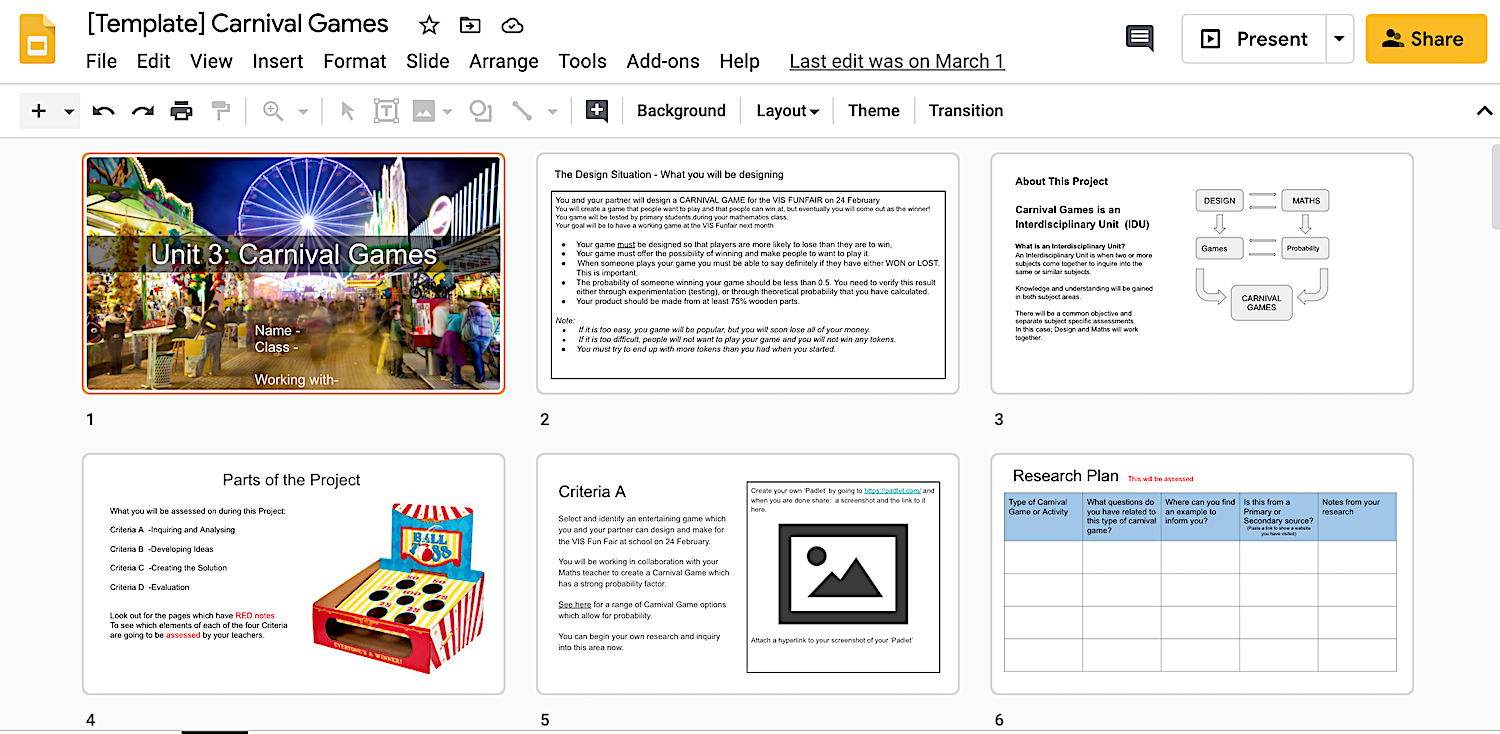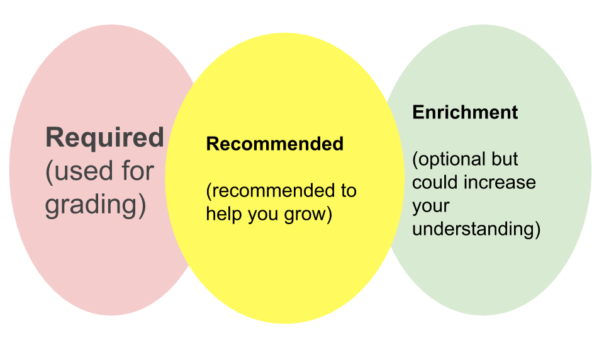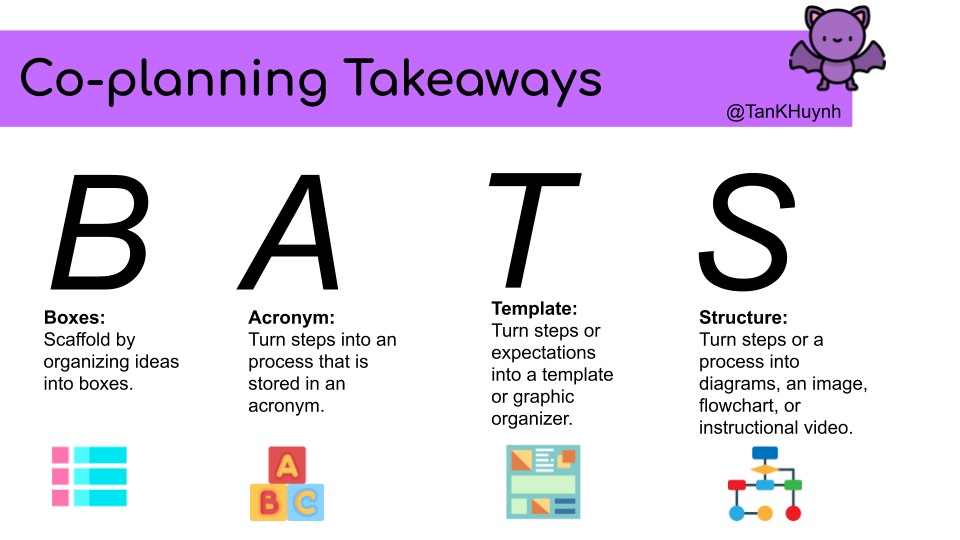How to Co-teach When You’re Not Even There
A MiddleWeb Blog

In co-planning, I also think in terms of the smallest viable deliverables. In this case, deliverables are those things I must identify or co-create with my content area teacher colleagues as part of our co-planning sessions.
I’ve created an acronym to help you remember the framework I use – BATS – boxes, acronym, template, structure. Here’s how it looks in practice.
The need
As a co-teacher I am assigned to a number of content teachers. This means that since I cannot be in 4 or 5 places at once, I cannot be in their classes every day to co-instruct with them. However, through the miracle of co-planning, I have learned that you can co-teach even when you’re not physically in the class.
The secret? As a takeaway from co-planning, you produce specific deliverables that will be used repeatedly for days or through the life of the unit. When the content teachers and I decide on a strategy, I can produce a visual that they can use even if I am not there in the room.
Throughout my eight years of co-planning, I began to notice that certain effective strategies came up again and again across grade levels and spanning all disciplines. These strategies were boxes, acronyms, templates, and structures. To help myself remember them, I use the acronyms BATS.
Boxes
Sometimes we have a lot of expectations for students or lots of prompts for them to think about. In these cases I often house these things in a table or box. For the sake of keeping to the BATS acronym, when I refer to boxes think of tables with columns and rows.
For example, let’s say that you are a science teacher, and you want students to write a lab report for an experiment. Part of the report has to identify the materials needed and how much was used. These things can be turned into a box with a column for materials and a column for how much of that material or equipment is needed to conduct the experiment.

Another highly useful way to present information on a rubric is through boxes. They can hold the standards, their descriptions, and the mastery scale. When you co-plan, a deliverable might be co-constructing a rubric that makes expectations clearer.
Acronym
An acronym is a mnemonic device that helps you remember certain details. The individual letters can help students remember key things they have to include.
For example my colleagues and I were co-planning the narrative unit. We wanted students to write using rich details and narrative elements in their stories. Therefore we created the DADI acronym. When pronounced, it sounds like daddy, which was memorable for students. The acronym stands for:
- D: Description
- A: Action
- D: Dialogue
- I: Inner thoughts
Before settling on DADI, we had other arrangements such as IADD, IDAD, AIDD, ADDI and DIDA. These were not options as they didn’t produce a recognizable word when pronounced, which is the key to making the acronym stick in student memory and being easy for us to teach.
Templates
Projects usually have many aspects, parts, layers and requirements. Think about a science lab report. It contains the research question, the hypothesis, the background, variables, data, analysis, and conclusion. When co-planning extensive, multi-day, multi-step projects, collaborate with your colleagues to create a template for the project. As students work, the template will guide their engagement with the task. You can also incorporate scaffolds such as:
- sentence frames and stems
- labeled diagrams
- word banks
- videos and other helpful links
- spaces for student responses
I often create templates using Google Docs for reports or Google Slides for portfolios. Because a single template might still be inaccessible to some in your class, you can easily differentiate them by engineering specific types of supports for specific students. Templates are super supports because they can contain the other three deliverables – boxes, acronyms and structures.

Structures
Structures are the umbrella term for scaffolds such as diagrams, flowcharts, and images. These supports “structure” the information or the steps students have to follow. When co-planning, look for ways to turn the instructions or information into a diagram, flowchart, or an image to empower language learners to be successful.
For example, when my colleagues and I were planning the science component of virtual school (caused by the COVID-19 pandemic) we used a graphic with three colors. The red symbolized things that students were going to be assessed on, the yellow was for things that we recommend to help them grow but did not require them to do, and the green was for enrichment activities that expanded their understanding but were also not required. The graphic was at the beginning of the Google Slide template for science each week. Every slide within the template had a red, yellow, or green background to indicate whether it was required, recommended or for enrichment.

Save time and increase impact
Your planning time is precious. When I first started, my co-teacher and I would usually leave the meeting empty-handed. Our dialogue was more of an information exchange. But now I intentionally look for these strategic items when I co-plan with colleagues.
When my colleagues and I produce a deliverable from BATS, the benefits include:
►improved teacher clarity
►more scaffolded instruction for students
►greater student success in engaging with the task
►increases in the content teacher’s skills for scaffolding EL instruction
►a stronger relationship between the co-teacher and the language specialist because we are co-constructing these deliverables
Using BATS can supply your effort and know-how when you are not physically present to support students. It can help you guide student learning even when you’re across the building.
Note: I do not try to create all four deliverables in each co-planning session, though that is possible. I simply approach co-planning sessions with the goal of supporting students and content teachers. The best way to do that most consistently and effectively is through co-creating these smallest viable deliverables: boxes, acronyms, templates, and structures.





































Thank you! I have seen BATS on other platforms and I am excited to figure out how to apply this to our newly implemented teacher team workflow. Intervention is the focus next year but this seems like it could really help our teams immensely! Love to connect!
Hi, Veronica.
I hope you like it. It’s such an easy way to co-plan with teachers! Please let me know if I can be of support! DM at @TanKHuynh on Twitter! We’re in this together!